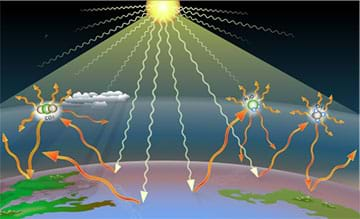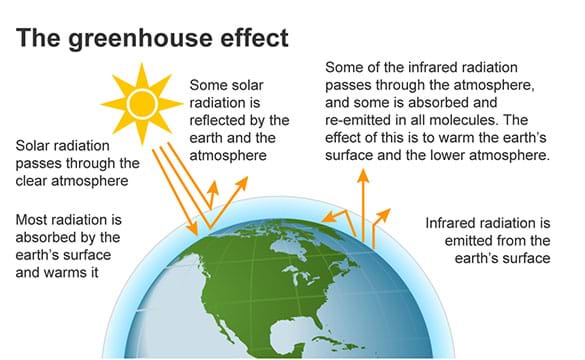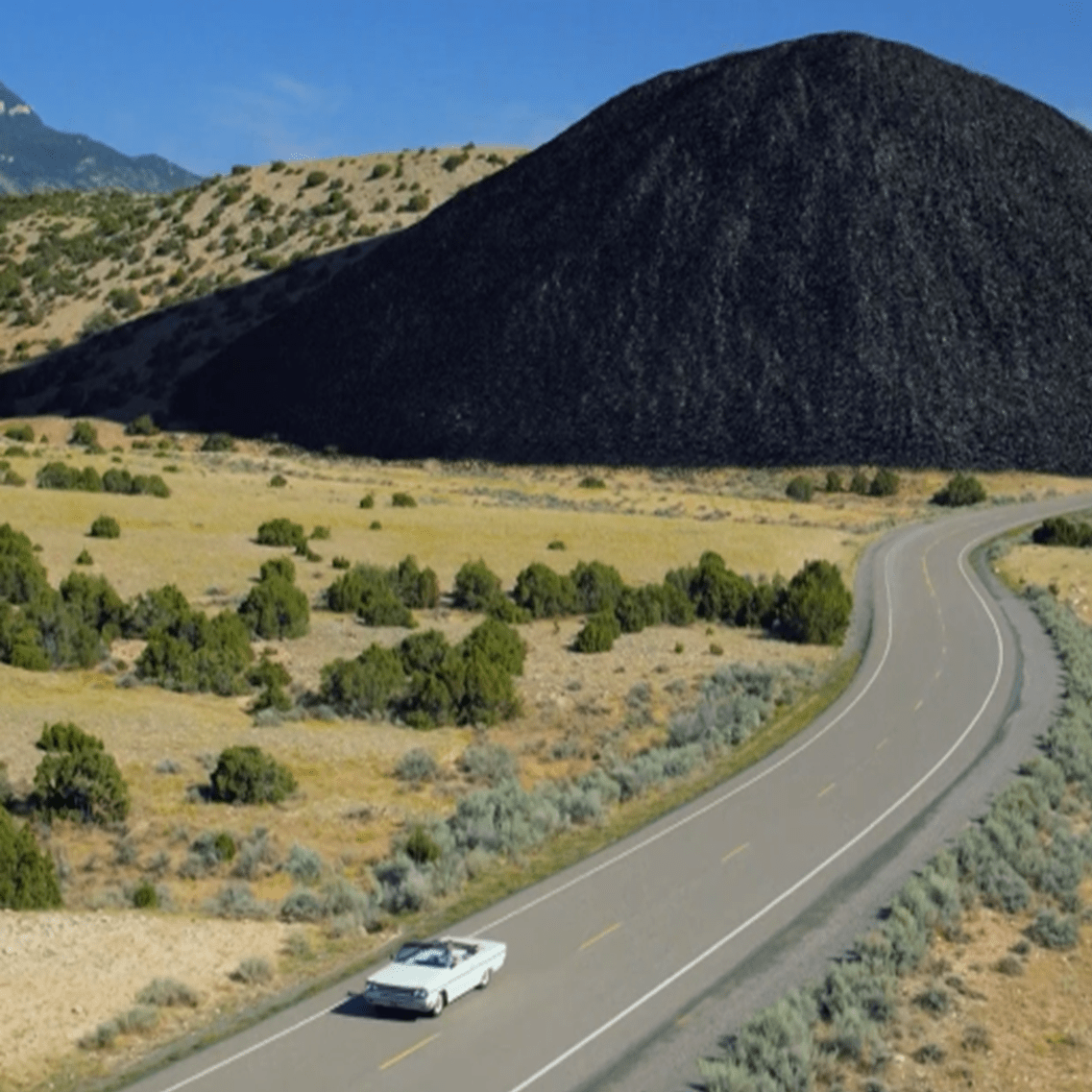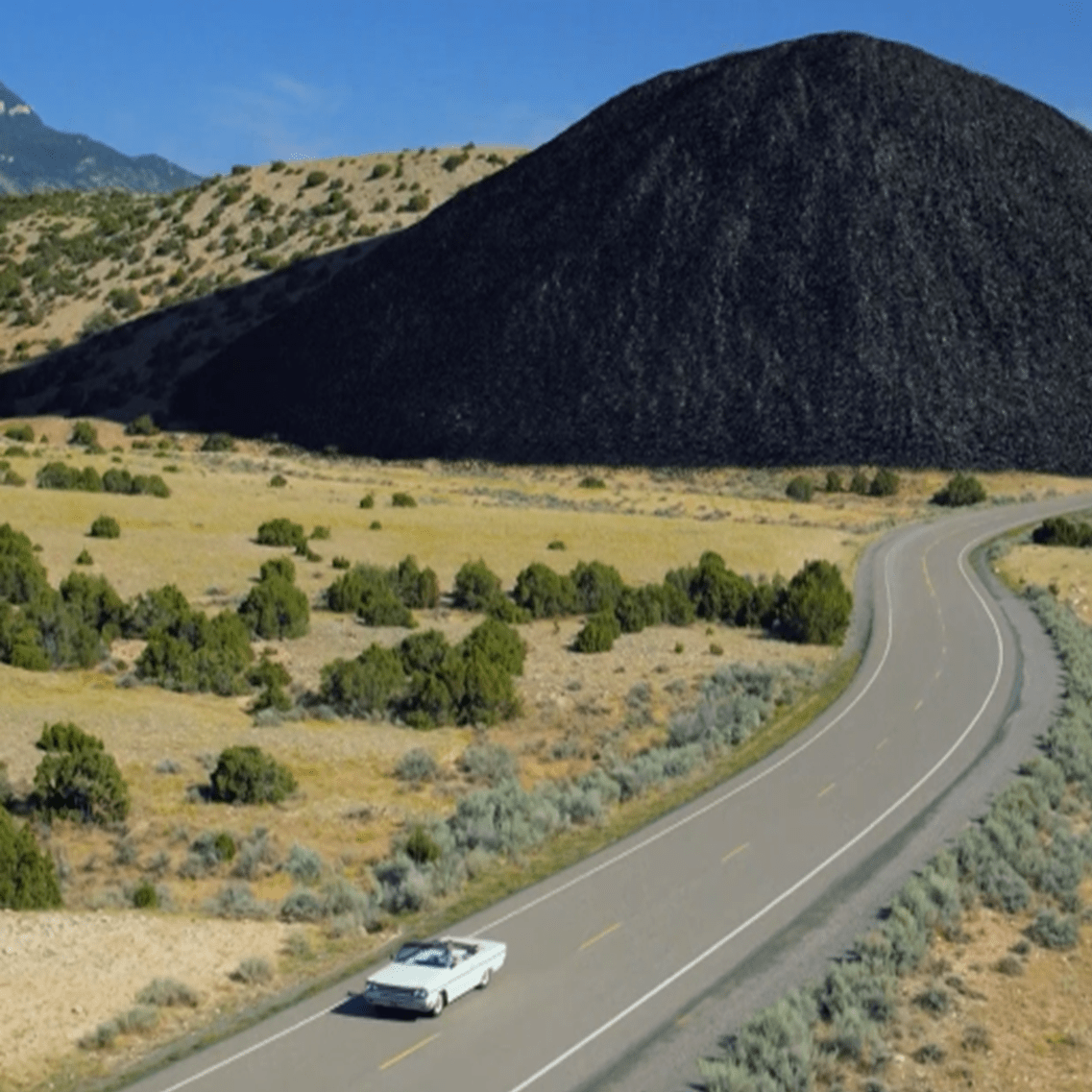Quick Look
Grade Level: 7 (6-8)
Time Required: 15 minutes
Lesson Dependency: None
Subject Areas: Earth and Space, Science and Technology
NGSS Performance Expectations:

| MS-ESS3-5 |
Summary
Students learn how the greenhouse effect is related to global warming and how global warming impacts our planet, including global climate change. Extreme weather events, rising sea levels, and how we react to these changes are the main points of focus of this lesson.
Engineering Connection
Engineers affect our planet in every design decision they make, from the choice of materials they use to the energy needed for their designs. For example, environmental engineers design products that aim to directly improve the environment, such as designing remediation systems to clean up a toxic spill. All engineers must have a global awareness in the design process and an understanding of how their decision can impact global climate change.
Learning Objectives
After this lesson, students should be able to:
- Describe the greenhouse effect and global warming.
- Explain the concept of climate change.
- Consider the effects of climate change on extreme weather.
- Recognize ways that they can lower their impact on the environment at home.
Educational Standards
Each TeachEngineering lesson or activity is correlated to one or more K-12 science,
technology, engineering or math (STEM) educational standards.
All 100,000+ K-12 STEM standards covered in TeachEngineering are collected, maintained and packaged by the Achievement Standards Network (ASN),
a project of D2L (www.achievementstandards.org).
In the ASN, standards are hierarchically structured: first by source; e.g., by state; within source by type; e.g., science or mathematics;
within type by subtype, then by grade, etc.
Each TeachEngineering lesson or activity is correlated to one or more K-12 science, technology, engineering or math (STEM) educational standards.
All 100,000+ K-12 STEM standards covered in TeachEngineering are collected, maintained and packaged by the Achievement Standards Network (ASN), a project of D2L (www.achievementstandards.org).
In the ASN, standards are hierarchically structured: first by source; e.g., by state; within source by type; e.g., science or mathematics; within type by subtype, then by grade, etc.
NGSS: Next Generation Science Standards - Science
| NGSS Performance Expectation | ||
|---|---|---|
|
MS-ESS3-5. Ask questions to clarify evidence of the factors that have caused the rise in global temperatures over the past century. (Grades 6 - 8) Do you agree with this alignment? |
||
| Click to view other curriculum aligned to this Performance Expectation | ||
| This lesson focuses on the following Three Dimensional Learning aspects of NGSS: | ||
| Science & Engineering Practices | Disciplinary Core Ideas | Crosscutting Concepts |
| Ask questions to identify and clarify evidence of an argument. Alignment agreement: | Human activities, such as the release of greenhouse gases from burning fossil fuels, are major factors in the current rise in Earth's mean surface temperature (global warming). Reducing the level of climate change and reducing human vulnerability to whatever climate changes do occur depend on the understanding of climate science, engineering capabilities, and other kinds of knowledge, such as understanding of human behavior and on applying that knowledge wisely in decisions and activities. Alignment agreement: | Stability might be disturbed either by sudden events or gradual changes that accumulate over time. Alignment agreement: |
Common Core State Standards - Math
-
Fluently add, subtract, multiply, and divide multi-digit decimals using the standard algorithm for each operation.
(Grade
6)
More Details
Do you agree with this alignment?
-
Solve unit rate problems including those involving unit pricing and constant speed.
(Grade
6)
More Details
Do you agree with this alignment?
-
Summarize numerical data sets in relation to their context, such as by:
(Grade
6)
More Details
Do you agree with this alignment?
International Technology and Engineering Educators Association - Technology
-
Students will develop an understanding of the effects of technology on the environment.
(Grades
K -
12)
More Details
Do you agree with this alignment?
-
Analyze how the creation and use of technologies consumes renewable and non-renewable resources and creates waste.
(Grades
6 -
8)
More Details
Do you agree with this alignment?
State Standards
Colorado - Math
-
Fluently add, subtract, multiply, and divide multidigit decimals using standard algorithms for each operation.
(Grade
6)
More Details
Do you agree with this alignment?
-
Solve unit rate problems including those involving unit pricing and constant speed.
(Grade
6)
More Details
Do you agree with this alignment?
-
Summarize numerical data sets in relation to their context.
(Grade
6)
More Details
Do you agree with this alignment?
Colorado - Science
-
Earth has a variety of climates defined by average temperature, precipitation, humidity, air pressure, and wind that have changed over time in a particular location
(Grade
8)
More Details
Do you agree with this alignment?
Worksheets and Attachments
Visit [www.teachengineering.org/lessons/view/cub_weather_lesson06] to print or download.Introduction/Motivation
Greenhouse gases (including CO2, water vapor and aerosols) are found in the atmosphere above the surface of the Earth. Their job is to trap heat reflected off the Earth from the Sun. You have probably experienced the greenhouse effect while sitting in a car that is parked in the Sun. The glass windows let in light but keep heat from escaping. If it is a bit chilly out, it may feel nice to get into a warm car, but on a hot day, it can be very uncomfortable to get inside a car that is rapidly warming up in the hot Sun. (You may even open the doors and let some of the hot air escape before getting in the car.)
The same is true for the Earth. Figure 2 illustrates how greenhouse gases warm up the Earth. If we did not have greenhouse gases, the Earth would be 60˚F colder! That would mean it would get down to (insert your typically low temperature minus 60°F based on the weather in your area) in the winter! So, it would be safe to say then that greenhouse gases are necessary to survive in our world; but, similar to sitting in a car on a really hot day, too much trapped heat can make it difficult to survive as well. A delicate balance — between what is necessary and what is too much — is key to our survival on this planet. Even small changes in our global climate can have a big impact on how we live.
What are some ways that you think global warming might affect people? (Give students a moment to write down and/or share their answers.) It is difficult to predict how global warming influences extreme weather events — such as hurricanes, tsunamis, and tornados, but we can be fairly certain that a warmer atmosphere will at least result in a greater number of extreme heat waves. More rain may be a result as well. Just as a puddle will disappear by evaporating more quickly on a hot summer day, a warmer planet allows more evaporation to occur resulting in more moisture in the atmosphere. This can lead to more frequent and heavier storms when that added moisture is released back onto the surface of the planet. Many scientists believe Hurricane Katrina, which hit the Gulf Coast in August 2005, was stronger due to the warmer waters it traveled over in the Gulf of Mexico, which caused more water to be evaporated into the storm clouds.
Our sea level has already risen 4-8 inches (10-20 cm) during the past century. Some scientists believe that if global warming continues, and our glaciers continue to melt adding more water into the ocean waters, that rising sea levels could flood coastal areas sending millions of inhabitants out of their homes around the world, all within this century. Can you imagine if coastal cities such as New York and San Francisco were underwater?!
Lesson Background and Concepts for Teachers
A worldwide effort, the Kyoto Protocol, is taking steps to limit the amount of greenhouses gases being released into the atmosphere by alloting a certain amount of allowed pollution (or "pollution credits") to every industrialized/developed country (except the U.S. who is not participating). Companies that have cut back on the amount of greenhouse gases they are releasing may sell their "pollution credits" to other companies who are over their allowed amount. For example, if one company is given 10 credits, and they only release 8 credits worth of greenhouses gases into the air, they can sell the other 2 credits to another company who is polluting over their limit.
Many scientists and engineers believe that human activity has contributed to global cliimate change, and that we can prevent it by limiting our output of greenhouse gases. What human activities create greenhouse gases? Most of it comes from burning fossil fuels (such as oil, gas and coal) for energy to light our houses, drive our cars, and manufacture products such as paper, plastics, computers, skateboards and packaged foods. Everything that we buy requires some form of energy to create it and then be made available for us to purchase it. Most of this energy comes from burning fuels such as coal and oil. Burning these fuels releases greenhouse gases, such as carbon dioxide. Greenhouse gases are sent into the air every time a new product is manufactured, and even more greenhouse gases are released into landfills as these products are thrown away. Landfill gas (LFG), naturally produced by the decomposition of organic materials in landfills, contains mostly methane and carbon dioxide — both of which are greenhouse gases that contribute to global warming. How can humans make small steps to reduce the amount of waste that ends up in landfills? Challenge students to design and build products made entirely from reused materials with the associated activity, Trash to Treasure!
Associated Activities
- Trash to Treasure! - Students design and build products made entirely from reused materials.
Lesson Closure
Much of our daily human activities directly or indirectly contribute to increasing greenhouse gases, which contribute to global warming. Engineers can help reduce the emission of harmful greenhouse gases by designing products that limit the production of these harmful gases.
Vocabulary/Definitions
climate: The average weather (usually taken over a 30-year time period) for a particular region and time period; the average pattern of weather for a particular region; climatic elements include precipitation, temperature, humidity, sunshine, wind velocity, and phenomena, such as fog, frost and hail storms.
climate change: The change in long-term weather patterns; changes can cause warmer or colder temperatures; annual amounts of rainfall or snowfall can increase or decrease.
global warming: Refers to an average increase in the Earth's temperature, which in turn causes changes in climate; a warmer Earth may lead to changes in rainfall patterns, a rise in sea level, and a wide range of impacts on plants, wildlife, and humans.
greenhouse effect: The effect produced as greenhouse gases allow energy from the sun to pass through the Earth's atmosphere, but prevent most of the outgoing heat from the surface and lower atmosphere from escaping into outer space.
greenhouse gas: Any gas that absorbs the sun's heat in the atmosphere, including water vapor, carbon dioxide (CO2), methane (CH4), nitrous oxide (N2O), halogenated fluorocarbons (HCFCs), ozone (O3), perfluorinated carbons (PFCs), and hydrofluorocarbons (HFCs).
Assessment
Pre-Lesson Assessment
Stop and Jot: Ask students to write down some ideas they have for ways to help the environment. After a few minutes, have them share their ideas. Some ideas include:
- Walk or ride your bike when possible.
- Turn off the TV, radio, computer and other electronics when not in use.
- Recycle.
- Buy recycled products.
- Plant a tree.
- Avoid buying products with a lot of packaging.
- Turn the heat and air conditioning down; just a couple of degrees can make a big difference.
- Replace light bulbs with energy efficient CFLs that use 60% less energy.
Questions: Have students come up with questions to ask eachother about global warming (i.e., what factors have caused the rise in global temperatures over the past century?). After the lesson, have students answer the questions.
Post-Introduction Assessment
Question/Answer: Ask the students a question and instruct them to raise their hands to respond; discuss their answers as a class:
- Can anyone think of other ways that a warmer planet may affect us besides just having hotter temperatures? (Possible answers: More rainfall in some areas, drought in some areas, heavier storms, higher sea levels, crops that no longer grow in certain locations, changes in our ecosystems, etc.)
Lesson Summary Assessment
Brainstorming: As a class, have students engage in open discussion. Remind them that in brainstorming, no idea or suggestion is "silly." All ideas should be respectfully heard. Take an uncritical position, encourage wild ideas and discourage criticism of ideas. Have students raise their hands to respond. Write their ideas on the board. Ask the students:
- What can you do to cut down the amount of greenhouse gases that you are contributing to the atmosphere?
Group Discussion/Presentation: With the class divided into groups of four students each, ask students to design posters that answer the following questions. Have teams present their posters in front of the class.
- What is global warming?
- What is causing global warming?
- How does global warming affect you?
- What can engineers do to prevent or slow down global warming?
Homework
Carbon Footprint Worksheet: Ask the students to take home the Carbon Footprint Worksheet and fill it out with their parents based on their family's energy use.
After completion of the worksheets, as a class compute the class mean footprint and discuss why some students have larger or smaller numbers.
Lesson Extension Activities
Have students complete one of the activities described in the U.S. Department of Energy's online teacher's toolbox as developed by the Atmospheric Radiation Measurement Program (ARMP); see: https://www.arm.gov/resources/outreach.
Subscribe
Get the inside scoop on all things TeachEngineering such as new site features, curriculum updates, video releases, and more by signing up for our newsletter!More Curriculum Like This

Students observe teacher-led demonstrations, and build and evaluate simple models to understand the greenhouse effect, the role of increased greenhouse gas concentration in global warming, and the implications of global warming for engineers, themselves and the Earth. In an associated literacy activ...

Students determine their carbon footprints by answering questions about their everyday lifestyle choices. Then they engineer plans to reduce them.

Students learn about climate change and what affects it. Students learn a basic understanding of the greenhouse effect, the carbon cycle, global warming, and how transportation can contribute to global warming. Students work together to understand how various forms of transportation have costs and b...

Students learn the concepts of climate change and how cars can contribute to climate change. Students learn the basics of the greenhouse effect and the carbon cycle. They also learn how transportation affects our atmosphere. Students work together to understand how various forms of transportation ha...
References
U.S. Department of Energy, Office of Science, Atmospheric Radiation Measurement Program, "Bringing Climate Change into the Classroom." ARM Education Program, North Slope of Alaska, 2002, October 28, 2008, accessed June 22, 2009. http://www.arm.gov/news/education/post/16864
U.S. Environmental Protection Agency, Climate Change Kids Site, October 30, 2008, accessed June 22, 2009. http://epa.gov/globalwarming/kids/
"Greenhouse Effect," October 23, 2006, accessed June 22, 2009. http://www.epa.gov/globalwarming/kids/greenhouse.html
U.S. Environmental Protection Agency, Global Warming – Climate, January 7, 2000, accessed June 22, 2009. http://www.epa.gov/climatechange/
Copyright
© 2009 by Regents of the University of Colorado.Contributors
Christie Chatterley; Malinda Schaefer Zarske; Janet Yowell; Karen King; Denise W. CarlsonSupporting Program
Integrated Teaching and Learning Program, College of Engineering, University of Colorado BoulderAcknowledgements
The contents of these digital library curricula were developed by the Integrated Teaching and Learning Program under National Science Foundation GK-12 grant no. 0338326. However, these contents do not necessarily represent the policies of the National Science Foundation, and you should not assume endorsement by the federal government.
Last modified: July 8, 2024









User Comments & Tips